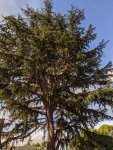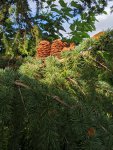You are using an out of date browser. It may not display this or other websites correctly.
You should upgrade or use an alternative browser.
You should upgrade or use an alternative browser.
Name of this tree please
- Thread starter vkk
- Start date
Silentrunning
Full Access Member
- Joined
- Oct 9, 2017
- Messages
- 1,300
- Reaction score
- 1,739
- Location
- Warrenton North Carolina
- Hardiness Zone
- 7b
- Country

Possible Larch or Deodar Cedar, Cedrus deodars. But a Cedar shouldn’t be loosing a lot of needles. 
Tetters
Full Access Member
The Japanese Cedar, more commonly called Cryptomeria actually belongs to the bald Cypress family.
These trees need to shed some of their older needles in early autumn to make way for new growth in the springtime.

These trees need to shed some of their older needles in early autumn to make way for new growth in the springtime.
cpp gardener
Full Access Member
- Joined
- Nov 13, 2019
- Messages
- 2,117
- Reaction score
- 928
- Location
- Riverside/Pomona CA
- Hardiness Zone
- 9
- Country

Silentrunning is right, it is probably an Atlas Cedar based on shape and cones. They sometimes lose a number of needles in the late fall but without turning colors like a Larch which is very uncommon in the SF Bay area.
Marck
Full Access Member
This is a Deodar Cedar (Cedrus deodara) one of the true Cedars in the Pine Family (Pinaceae). Depending on the author, there are two, three, or four species of Cedrus, all of which are quite similar with overlapping traits. However, the large size of the cones in the second picture suggest that Cedrus deodara is the most likely species.
Ask a Question
Want to reply to this thread or ask your own question?
You'll need to choose a username for the site, which only take a couple of moments. After that, you can post your question and our members will help you out.
Similar Threads
Staff online
-
MeadowlarkNo N-P-K Required
Forum statistics
Latest Threads
-
TN Garden 2025
- Started by gary350
-
Easy Vegetable Dehydrator.
- Started by gary350
-
Blueberry Bushes Wilting
- Started by goose70
-
Eliminating Ivy that does not belong to Susan
- Started by LouisFerdinand
-
Banana plant dying
- Started by kken
-
Stones on pathway
- Started by RICHARD77
-
Please help identify
- Started by Poodlemom
-
Gardening design for newbies
- Started by BramblyHedge
-
Tomato Problem
- Started by stevenh
-
Newbie with tiny garden spot
- Started by chris330r



